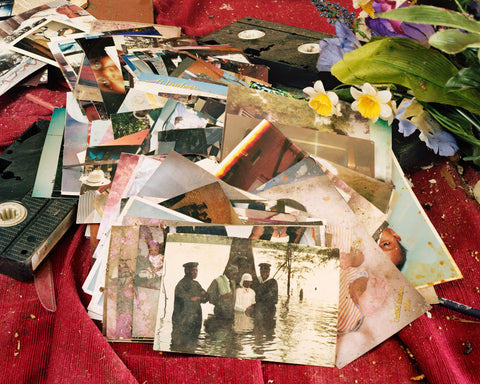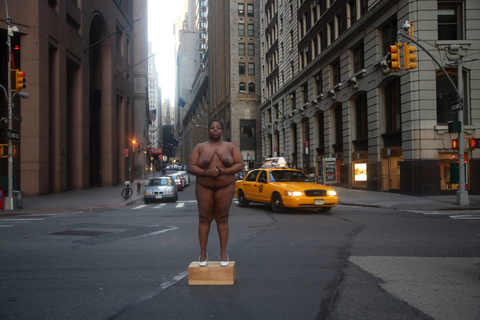
Installation view, Arthur Jafa, Love Is The Message, The Message Is Death, 2016. Sant’Andrea de Scaphis, Rome
(13 March–14 April 2018)
Two points in time — two sets of events — sing out in retrospect as I try to assess the record of the work gathered here and the time of its making. The first took place while I was back home in London, in the late summer of 2011, when after the police shot dead young, black Mark Duggan in North London, protests at a local police station swiftly escalated, through exchanges of violence, to a riot that spread from Tottenham Hale to numerous regions of the capital and the country, and lasted for five days.1 The second is the white riot at the US Capitol on 6 January 2021, in which a crowd of pro-Trump supporters was incited by the President and his supporters to besiege the Capitol, and swiftly swarmed the modest defences of the Capitol Police to invade the building itself. Inside, elected members of Congress were engaged in ratifying the results of an election that had seen the (temporary?) demise of the Trump presidency, as a consequence of black and brown votes in Detroit, Philadelphia, Pittsburgh, Atlanta, Las Vegas, and Phoenix swinging the electoral college decisively to Biden’s column.

Installation view, Arthur Jafa, A Series of Utterly Improbable, Yet Extraordinary Renditions, 2018. Julia Stoschek Collection, Berlin
(11 February–25 November 2018)
In both instances, the functioning of ‘proper order’ was suspended in palpable, intensely discombobulating and profound ways. In the first, poor communities who are specifically and disproportionately targeted by the violence of policing selectively and emphatically engaged in the praxis of the riot as a refusal of hegemonic order, and in their subsequent looting, merely mimicked the long-run raid on the public coffers that austerity hides beneath the familial language of parsimony. In the latter instance, the ghosts of white riots built on the massacre of black Americans echoed the devastation of Tulsa, Oklahoma in 1921, and of Wilmington, North Carolina in 1898, as white nationalists persuaded of their indefensible dispossession by black and brown electoral votes launched unfettered violence against the institutions of the state.
At play in the interregnum created by both riots was a momentary freedom, but of wholly different orders. In London, Gloucester, Manchester, and so many other parts of England, violence was confined locally to the origins of each flickering point in the spreading conflagration; in the American instance, rioters travelled to the nation’s capital from all across the country, and were free to stroll aimlessly through the halls of government as their elected officials cowered in terror in their locked offices and safe rooms. Where shock troops with automatic rifles, sound canons, and armoured personnel carriers policed unarmed black and brown protesters in Wisconsin in August 2020, the Capitol Police met Trump’s light brigade on foot and in paltry numbers. The differential definition of threat in these two instances breaks evenly along racial lines, and the fiction that policing seeks to uphold the law, rather than to protect specific bodies from a suite of degenerate ‘others’, fades into farce at the conjunction.

Dana Lixenberg, Basima and Keithayonna, 2008. From Imperial Courts (2015)
This is to say that, even within the strict confines of the United States, the past decade has been one in which the orthodoxies of ‘normal operations’ have been visibly, spectacularly, and comprehensively set aside by massed human action, even if only temporarily. This is to say that what we have seen these this past decade, and with recurrent frequency through this short century, is the extent to which the absolute, notionally immutable tenets of social order have been shown to be only lightly held in place, their rupture often representing a precious political opening for new imaginaries, their repair occasioned through swingeing acts of state violence. In so many ways, the optic of this new century has been conflagration and catastrophe.
The profound, systemic ruptures brought about by Covid-19 only intensify recognition of this hard-won fact: reality is alterable all of an instant (spread the word!). It is a fact whose contingent, mutable appearance we can trace from the WTO protests in Seattle in 1999 through September 11, 2001, or from the March for Women’s Lives (2004) to Hurricane Katrina (2005–) to the emergence of the Tea Party (2009). We can track it from Occupy Wall Street and the subsequent wave of occupations (2011–) to the arrival of Black Lives Matter (2013) and its metastasis in the heat of the Ferguson Rebellion (2014–), or from the Standing Rock Protests against the Dakota Access Pipeline (2016–) to the Women’s March (2017), or from the Unite the Right march for white supremacy in Charlottesville (2017) to Hurricane Maria’s devastation of the Caribbean (2017–), or from the Migrant Caravans from southern and central America (2018) and the moral infamy of child separation as national policy to the student demonstration March for Our Lives (2018), and on through the Proud Boys pro- tests and counterprotests in Oregon (2019) to the Global Climate Strike (2019), or through the outbreak of Covid-19 (2020–) and the George Floyd rebellion (2020–)2 to the mass eruption of protest and demonstration in support of Palestinian liberation (2021–).3
I cite the foregoing events, what Hortense Spillers might call a ‘drive- thru’ of history,4 because I believe that from an ethical standpoint it is essential to account for the conditions of my viewing, to acknowledge and to seek some measure of the broader moment in which that viewing has unfolded, and to think through its effects on — or segregation from — my, yours, or perhaps our everyday experience. Photography, after all, happens in a given world, and these largely American artists have been given this world to work in, to reckon with, or to survive.
The question that emerges from this for me, in the precincts of fine art, is how can or might or should this recent history affect our individual and shared imaginaries? How can we see the same downtrodden streets, the same woods, the same skies, the same buildings and open spaces in the same way in the wake of such profound, spontaneous invention, calamity, and rebellion? What would it mean to ‘go back to normal’ in the face of such events, and could such a return constitute anything more than disavowal? These eruptions have histories, they do not emerge fully formed from an ahistorical vacuum, which means that the forces that subtend such extraordinary events as I have summarised here have been with us all along.
I should qualify or, at the least, question a word like ‘extraordinary’, given the very ubiquity of crisis in contemporary life — given the length of my tremendously incomplete list.5 It may well be that such a term preserves a certain indulgent innocence on the part of its user — a capacity to keep hold of shock and disbelief at the recurrence of a pattern that we know, deep down, to be pathological in its repetitions. ‘Extraordinary’ as a descriptor of contemporary catastrophe defers a necessary reckoning with the profound disjuncture between the realities of the world, and the account of it that we need (that I need?) to preserve in word and image — a disjuncture that serves in the ongoing task of making a manageable life in the fissured present. Have we been looking, these many years, at the combustible surfaces of our historical present? Have we been paying attention? The simple proposition of this book is that these artists certainly have.
Notes
- For a superb analysis of these events and the histories that forged them, see Endnotes, ‘A Rising Tide Lifts All Boats: Crisis Era Struggles in Britain’, Endnotes Journal, 3, (2013) <https://endnotes.org.uk/issues/3/en/endnotes-a-rising-tide- lifts-all-boats> [accessed 31 May 2021].
- For a superb analysis of these events and the histories that forged them, see Tobi Haslett, ‘Magic Actions’ n+1 (7 May 2021) <https://nplusonemag.com/online- only/online-only/magic-actions/> [accessed 31 May 2021].
- Though many of the cited events are notionally delimited to one specific moment or period in time, their effects are often undeniably ongoing, systemic and in so many instances irreparable. To fix them in a static pastness would be to cut off that ongoingness.
- Hortense J. Spillers, ‘Fly Me to the Moon (from the ground),’ boundary2 (December 11 2020) <http://www.boundary2.org/2020/12/hortense-j-spillers-fly-me-to-the- moon-from-the-ground/> [accessed 31 May 2021].
- T.J. Clark writes: ‘isn’t modernity the life-form of permanent crisis? Haven’t
we learned by now that capitalism depends on—thrives on—moments of social overreach and massive destruction of its own productive powers? And isn’t one main function of modernity—again, meaning the whole battery of social and rep- resentational apparatuses whose job is to endlessly reinvent a subject-relation to risk and anomie and breakdown (a subjection to society in free flow)—isn’t the task of that battery to make crisis livable?’ T. J. Clark, ‘Capitalism without Images’, Capitalism and the Camera: Essays on Photography and Extraction, ed. by Kevin Coleman and Daniel James (London: Verso, 2021), p. 124.

Paperback with flaps
14 x 22.8cm, 240 pages
ISBN 978-1-913620-39-4
October 2021
€30 £25 $35
Add to cart





